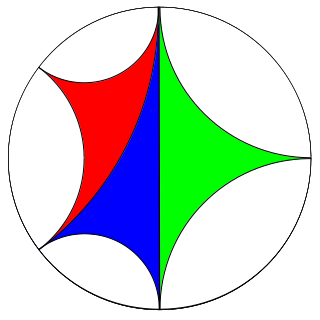
Euclidean geometry is a mathematical system attributed to ancient Greek mathematician Euclid, which he described in his textbook on geometry, Elements. Euclid's approach consists in assuming a small set of intuitively appealing axioms (postulates) and deducing many other propositions (theorems) from these. Although many of Euclid's results had been stated earlier, Euclid was the first to organize these propositions into a logical system in which each result is proved from axioms and previously proved theorems.

Euclidean space is the fundamental space of geometry, intended to represent physical space. Originally, in Euclid's Elements, it was the three-dimensional space of Euclidean geometry, but in modern mathematics there are Euclidean spaces of any positive integer dimension n, which are called Euclidean n-spaces when one wants to specify their dimension. For n equal to one or two, they are commonly called respectively Euclidean lines and Euclidean planes. The qualifier "Euclidean" is used to distinguish Euclidean spaces from other spaces that were later considered in physics and modern mathematics.
In mathematics, projective geometry is the study of geometric properties that are invariant with respect to projective transformations. This means that, compared to elementary Euclidean geometry, projective geometry has a different setting, projective space, and a selective set of basic geometric concepts. The basic intuitions are that projective space has more points than Euclidean space, for a given dimension, and that geometric transformations are permitted that transform the extra points to Euclidean points, and vice versa.
Synthetic geometry is geometry without the use of coordinates. It relies on the axiomatic method for proving all results from a few basic properties initially called postulate, and at present called axioms.

In mathematics, an affine space is a geometric structure that generalizes some of the properties of Euclidean spaces in such a way that these are independent of the concepts of distance and measure of angles, keeping only the properties related to parallelism and ratio of lengths for parallel line segments. Affine space is the setting for affine geometry.
In geometry, parallel lines are coplanar infinite straight lines that do not intersect at any point. Parallel planes are planes in the same three-dimensional space that never meet. Parallel curves are curves that do not touch each other or intersect and keep a fixed minimum distance. In three-dimensional Euclidean space, a line and a plane that do not share a point are also said to be parallel. However, two noncoplanar lines are called skew lines. Line segments and Euclidean vectors are parallel if they have the same direction.
Absolute geometry is a geometry based on an axiom system for Euclidean geometry without the parallel postulate or any of its alternatives. Traditionally, this has meant using only the first four of Euclid's postulates. The term was introduced by János Bolyai in 1832. It is sometimes referred to as neutral geometry, as it is neutral with respect to the parallel postulate. The first four of Euclid's postulates are now considered insufficient as a basis of Euclidean geometry, so other systems are used instead.

The Sylvester–Gallai theorem in geometry states that every finite set of points in the Euclidean plane has a line that passes through exactly two of the points or a line that passes through all of them. It is named after James Joseph Sylvester, who posed it as a problem in 1893, and Tibor Gallai, who published one of the first proofs of this theorem in 1944.
Theodorus of Cyrene was an ancient Greek mathematician who lived during the 5th century BC. The only first-hand accounts of him that survive are in three of Plato's dialogues: the Theaetetus, the Sophist, and the Statesman. In the former dialogue, he posits a mathematical construction now known as the Spiral of Theodorus.
Tarski's axioms are an axiom system for Euclidean geometry, specifically for that portion of Euclidean geometry that is formulable in first-order logic with identity. As such, it does not require an underlying set theory. The only primitive objects of the system are "points" and the only primitive predicates are "betweenness" and "congruence". The system contains infinitely many axioms.

A Saccheri quadrilateral is a quadrilateral with two equal sides perpendicular to the base. It is named after Giovanni Gerolamo Saccheri, who used it extensively in his 1733 book Euclides ab omni naevo vindicatus, an attempt to prove the parallel postulate using the method reductio ad absurdum. Such a quadrilateral is sometimes called a Khayyam–Saccheri quadrilateral to credit Persian scholar Omar Khayyam who described them in his 11th century book Risāla fī šarḥ mā aškala min muṣādarāt kitāb Uqlīdis.
In geometry, Max Dehn introduced two examples of planes, a semi-Euclidean geometry and a non-Legendrian geometry, that have infinitely many lines parallel to a given one that pass through a given point, but where the sum of the angles of a triangle is at least π. A similar phenomenon occurs in hyperbolic geometry, except that the sum of the angles of a triangle is less than π. Dehn's examples use a non-Archimedean field, so that the Archimedean axiom is violated. They were introduced by Max Dehn (1900) and discussed by Hilbert.

In hyperbolic geometry, an ideal point, omega point or point at infinity is a well-defined point outside the hyperbolic plane or space. Given a line l and a point P not on l, right- and left-limiting parallels to l through P converge to l at ideal points.
In geometry, Pasch's axiom is a statement in plane geometry, used implicitly by Euclid, which cannot be derived from the postulates as Euclid gave them. Its essential role was discovered by Moritz Pasch in 1882.
Foundations of geometry is the study of geometries as axiomatic systems. There are several sets of axioms which give rise to Euclidean geometry or to non-Euclidean geometries. These are fundamental to the study and of historical importance, but there are a great many modern geometries that are not Euclidean which can be studied from this viewpoint. The term axiomatic geometry can be applied to any geometry that is developed from an axiom system, but is often used to mean Euclidean geometry studied from this point of view. The completeness and independence of general axiomatic systems are important mathematical considerations, but there are also issues to do with the teaching of geometry which come into play.
In absolute geometry, the Saccheri–Legendre theorem states that the sum of the angles in a triangle is at most 180°. Absolute geometry is the geometry obtained from assuming all the axioms that lead to Euclidean geometry with the exception of the axiom that is equivalent to the parallel postulate of Euclid.
In algebra, a Pythagorean field is a field in which every sum of two squares is a square: equivalently it has Pythagoras number equal to 1. A Pythagorean extension of a field is an extension obtained by adjoining an element for some in . So a Pythagorean field is one closed under taking Pythagorean extensions. For any field there is a minimal Pythagorean field containing it, unique up to isomorphism, called its Pythagorean closure. The Hilbert field is the minimal ordered Pythagorean field.

In geometry, the parallel postulate, also called Euclid's fifth postulate because it is the fifth postulate in Euclid's Elements, is a distinctive axiom in Euclidean geometry. It states that, in two-dimensional geometry:
If a line segment intersects two straight lines forming two interior angles on the same side that are less than two right angles, then the two lines, if extended indefinitely, meet on that side on which the angles sum to less than two right angles.

In geometry, Playfair's axiom is an axiom that can be used instead of the fifth postulate of Euclid :
In a plane, given a line and a point not on it, at most one line parallel to the given line can be drawn through the point.
The Lotschnittaxiom is an axiom in the foundations of geometry, introduced and studied by Friedrich Bachmann. It states:
Perpendiculars raised on each side of a right angle intersect.











